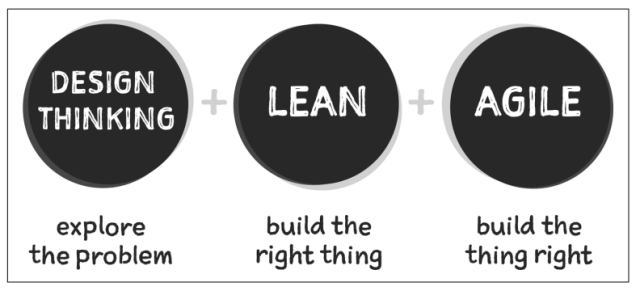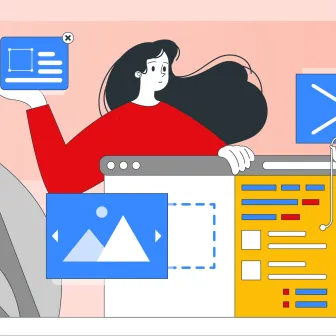Agile has been considered one of the finest software development life cycle practises. Its certifications and other related accolades have made it a never ending thesis which is also great when being implemented.
When people in the business landscape talk about lean, what they mean is process optimisations and having an extremely trimmed out team which can do wonders professionally. Lean is a mindset which needs to be developed overtime and learn to learn skill sets which can be carried out individuals without the need of hiring for that very purpose.
Lean Teams, Design thinking and agile can do wonders together, it is all about channeling processes and sessions to get the best possible output out of it.

What’s design thinking?
Design thinking involves getting deeper into assuming and understanding what the user’s pain points can be, redefine problem statements and address them proactively. It brings out innovative thinking in terms of design and sets an epitome for processes. These are the usual design thinking processes:
- Understanding your users and empathizing with them
- Defining your user personas and what problems do they face
- Challenging the assumptions and making innovative solution oriented contributions
- Developing a mockup or prototype of the solution and how does it address those problems.
- Run tests on the derived solutions and the product functions to make sure it performs as per expectations.
What's lean ?
“Lean startup is a methodology for developing businesses and products, which aims to shorten product development cycles and rapidly discover if a proposed business model is viable; this is achieved by adopting a combination of business-hypothesis-driven experimentation, iterative product releases, and validated learning.” — Wikipedia
This methodology was born in the 1990s in the silicon valley as the startup culture emerged and business started to evolve at a dramatically rapid pace. But the word lear actually emerged from one of Toyota’s lean production methodologies and how well was it benefiting them, it brought about a revolution in efficient manufacturing and production.
What’s agile ?
Agile, many would be familiar with this, to break it further, it is a way of addressing projects and progress around the development teams. It defined production, delivery and discipline among software development teams and is considered to be one of the game changing methodologies in the software development life cycle industry.
How to make them work together

Your sprints rounds should be short
Your sprints to be iteration friendly, it shouldn’t take teams a heck of a headache to process a change which is being requested by peers or stakeholders for that matter.
Change is reactive and people perceive it in different ways, assuming how would a change impact a person in the team or the entire project is good and preparing for it in advance always make sense. What if that change brings about enormous amount of efficiency in the product and makes also helps it economically. You don’t have to be change averse, instead be prone to change and prepare in advance for it. It is a prime component of design based thinking, agile operations and lean mindsets.
Sprint Retrospectives should be held regularly
Having regular sprints retrospectives apart from your virtual scrum boards can help you assess the project’s progress and necessary actions in advance. It is an agent which brings about continuous improvement in the agile environment. The teams should be self accountable and analyse things by themselves, the progress made should be transparent to each and every team member and they should be able to assume and make calculated risks to reach a certain point in the project. For teams they have proven to be good and for some they are just venting session but if used frequently, they can be great change activators.
Discovering the product should be supreme priority
Visualizing the product is tough and discovering every little functionality can be challenging for teams as it is based on the requirements gathered product expertise which lies across the team. Do not let the team figure out a major chunk of the product in one go as it will confuse a lot of things.
The benefit of doing this before hand or during the initial stages of the product is to make sure the requirements are in sync with the stakeholders and so the agile team can commence work and they have a confident enough direction to head in. Slowly the work gets visualised as it gets completed by the developers on both the back and the front end, it is always a hand in hand process. Which is the true nature of agile, continuous development and on the go gratification.
Revisit your compensation structure
If your teams don’t feel compensated well, they will eventually never feel motivated enough to go full soul on the project. There will always be a feeling in the back of their which hampers productivity and efficiency and impacts the projects deliverables and the executing team’s enthusiasm equally.
The best you can do is conduct a survey and let them be heard about their views on the compensation package or the incentives they receive. This will dramatically boost their will to deliver their life’s best work everyday and hence boosting the project’s overall momentum and making sure they feel accountable and responsible for the entire span of the project.
This is one of the best practices to ensure the teams are at full force and motivation since they are being incentivised to achieve excellence in every given project.
Final word
Everything comes into play at any organisation and in any given teams, the crux of the situation is that agile teams are famous for getting things done in a systematic, organised and extremely disciplined manner, and things can evolve when design thinking, lean and agile work together. Overall, if your team knows that the organization values cross functional behavior, they will act proactively and evolve their approach to things.
Subscribe
Related Blogs
UX Best Practices for Website Integrations

Website Integrations determine whether users stay engaged or abandon a site. I experienced this firsthand with a delivery…
How design thinking acts as a problem solving strategy?

The concept of design thinking is gaining popularity these days since people across different industries are using it as a…
10 major challenges that come across during an agile transformation

It’s no longer a mystery that agile was created as a response to the various concerns that the traditional waterfall…




